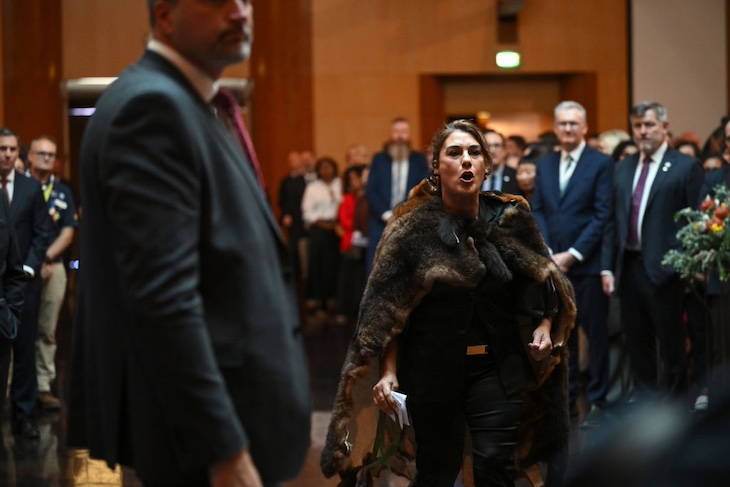King Charles and Queen Camilla flew to Samoa for the Commonwealth leaders’ meeting early on Wednesday, after completing their visit to Australia the previous day. Not, however, without again being confronted by the historic grievances of Aboriginal community leaders.
It was a disgraceful display of look-at-me exhibitionism, but Monday’s one-woman disruption of the King and Queen’s formal welcome by part-Aboriginal firebrand senator and full-time activist, Lidia Thorpe, gave others licence to express their concerns directly to King Charles. It was no surprise that they took the heavily indigenous-flavoured last day of the royal itinerary to do just that.
Unlike Thorpe’s outbursts on Monday, those remonstrations were very polite and low-key. But they were made nonetheless. Visiting the National Centre for Indigenous Excellence in Sydney, the King was met by community elders, including ‘Uncle’ Alan Murray. Murray said directly to the King, and referring directly to Thorpe’s outburst, ‘We’ve got stories to tell, and I think you witnessed that story yesterday in Canberra,’ he said.
‘But the story is unwavering, and we’ve got a long way to achieve what we want to achieve and that’s our own sovereignty,’ Murray added. Other Aboriginal leaders who welcomed the King also politely hinted at the same message.
Yet the King was also welcomed by another elder with a big hug, and all present made clear he was honoured and welcome in their ‘country’.
Elsewhere in Sydney, an activist was arrested for throwing red paint over a statue of Queen Victoria outside a major city building named for her. Another activist, an Aboriginal man in his version of traditional garb, was removed from the Sydney Opera House. He was goading a fraction of the crowd waiting there to see the King and Queen by shouting ‘not my King’ – knowing, like Thorpe, he was guaranteed the TV cameras’ attention.
The rest of the royal day went well. In brilliant spring weather, a community barbeque in western Sydney attracted thousands. Many there met the King and Queen, and much amusement was had when the King suddenly stopped reading his speech, exclaiming ‘God Almighty, they’ve done two pages of this bloody thing!’, before ad libbing his way out of the problem.
The King and Queen’s last event, the big public and very friendly gathering at the Opera House, also attracted thousands of Sydneysiders, including many schoolchildren excited at the prospect of meeting the royal couple. It was a happy and good-natured finish to what was, almost totally, a very happy visit Down Under.
But what of Lidia Thorpe?
Her stunt on Monday gave her exactly what she wanted: saturation coverage of herself and her radical, even extremist, version of the indigenous cause. Her social media posting of a vile cartoon of a beheaded King (subsequently deleted and blamed conveniently on her staff) deliberately fed the fire. Unsurprisingly, Australian and international media – including Sky’s Kay Burley in an excruciating interview – clamoured to hear her. She brushed off Australian opposition leader Peter Dutton’s call for her to resign, telling the Australian Broadcasting Corporation that ‘I’m not looking to be re-elected, I’m looking for justice for my people. I will be there for another three years everybody’.
In short, she wants to carry on using her parliamentary office exclusively for her single-issue activism. Never mind that it is tax-funded by the best part of a million Australian dollars a year (£515,000) for salary, staff and expenses.
Later, the opposition dropped calls for Thorpe’s parliamentary censure for her disrespectful behaviour. ‘She’ll just wear it like a badge of honour’, a frontbench Liberal senator, James Paterson, told Sydney radio.
On Wednesday, as the King and King flew out, Melbourne’s The Age newspaper came out in support of Thorpe. The left-leaning paper did not condone how she delivered her message, but endorsed the message itself, adopting the activist fiction that George III and his Hanoverian successors were personally responsible for colonising Australia and its consequences for the native inhabitants. The paper called for the King to apologise personally for his ancestors’ supposed deeds. ‘[Thorpe’s] approach to the King may appear similarly inflammatory, but on this occasion it is a product of the ashes from which her anger has risen’, the leader thundered.
Nevertheless, Thorpe should probably count herself lucky that she is in Australia, not Britain, with its hate speech laws. She has, as so many times before in Australia, got away with her volatile and incendiary antics, knowing full well she is all but untouchable, as Paterson conceded.
The various exchanges and incidents about Aboriginal rights and perceived historical grievances partially overshadowed the last two days of the royal visit, but that didn’t detract from the overwhelming success and goodwill of the visit itself.
The King and Queen left Australia with warm memories and it’s clear that, for the King himself, Australia continues to be a happy place where he can be the monarch and yet publicly unwind and relax. Charles and Camilla will continue to be welcome to this country and, for most Aboriginal Australians, welcome to their ancestral lands.







Comments